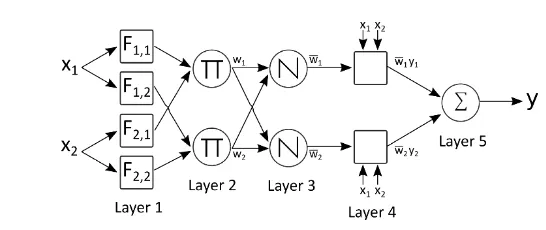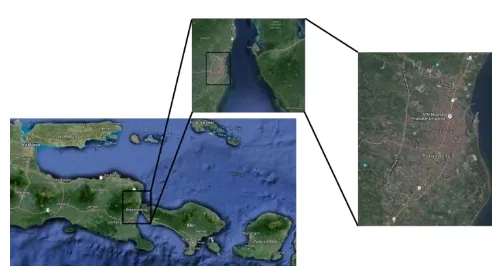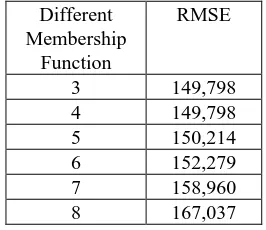Journal Homepage: www.jitecs.ub.ac.id
Rainfall Forecasting in Banyuwangi Using Adaptive Neuro
Fuzzy Inference System
Gusti Ahmad Fanshuri Alfarisy and Wayan Firdaus Mahmudy
Universitas Brawijaya, Faculty of Computer Science, Intelligent System Research Group, Indonesia
(gusti.alfarisy@gmail.com, wayanfm@ub.ac.id)
Received 20 November 2016; accepted 08 February 2017
Abstract. Rainfall forcasting is a non-linear forecasting process that varies according to area and strongly influenced by climate change. It is a difficult process due to complexity of rainfall trend in the previous event and the popularity of Adaptive Neuro Fuzzy Inference System (ANFIS) with hybrid learning method give high prediction for rainfall as a forecasting model. Thus, in this study we investigate the efficient membership function of ANFIS for predicting rainfall in Banyuwangi, Indonesia. The number of different membership functions that use hybrid learning method is compared. The validation process shows that 3 or 4 membership function gives minimum RMSE results that use temperature, wind speed and relative humidity as parameters.
1
Introduction
A Climate that occured in a region is commonly determined by the weather event. It is the average of weather event in a long period in the region. While the weather is an event in nature that occur in a relatively short time and fluctuative caused by the influence of the atmosphere [1]. Rainfall play a huge role in climate classification. Thus, the climate in the region strongly influenced by rainfall. By knowing the climate in the region, we can do better planning issues in several domain problems such as agriculture, business, transport, tourism, potential disaster and others.
The occurrence of rain will affect the behavior of biological life. Such as the relationship between the number of occurrences of dengue fever in Indonesia with the climate [2], the influence of tourists to tourist destinations, and behavior when traveling and travel business [3]. This relationship shows linkages of biological behavior in nature with the rainfall in the region. Changes in human behavior due to climate change will be easily planned if patterned and predictable. Rainfall forecasting model can help people in planning / designing some aspects of the issue such as transport systems, cultivation, tourism, flood control and others against climate change.
66 JITeCS Volume 1, Number 2, 2016, pp 65-71
This means that not all areas that near the equator has a tropical climate [4]. Aldrian [5] divided the climate based on rainfall patterns into three regions, namely A, B, and C. Region A, B, and C respectively are in the south, northwest, and the flow of sea traffic (Arlindo) Indonesia. Region A has a pattern like the letter U where high rainfall at the beginning and end of the year. Region B has a pattern M and Region C had the opposite of the pattern A pattern where high rainfall in the middle of the year.
However, the pattern can be shifted from the pattern predefined by previous studies. A study shows Indonesia is facing the challenge of climate change that is significant enough to alter the intensity of the rain and have a negative impact on the economy, health and environment. So, we need an effective and appropriate strategies to address climate change [6]. Climate change is a dynamic situation which several studies give different result eventhough the time between studies is short [7].Thus further studies are required in developing forecasting model that can adapt with the rapid climate change.
Predicting the rainfall is a complex process due to the incidence of rain is non linear and dynamic. Many studies have tried to modeling rainfall forecasting to predict accurately. Such as statistical model approach like Multiple Linear Regression and artificial intelligence approaches like Fuzzy Inference System [8], Artificial Neural Networks (ANN) and Adaptive Neuro Fuzzy Inference System (ANFIS). Comparison of these approaches show ANFIS and GA predict more accurate than other methods. And ANFIS that use hybrid training method give better results [9]. Another study shows that ANFIS is better than ANN in forecasting rainfall monthly [10]. Since the popularity of ANFIS in predicting rainfall, further investigation is needed in forecasting rainfall using ANFIS.
2
Related Work
Numerous studies have employed ANFIS as a method for forecasting the rainfall in different area. The result shows that ANFIS is outperform to other method like ANN and Fuzzy Inference System [9–11].
Another study analyze the sensitivity of the type of membership function, the different number of membership function and the different lead time in ANFIS for rainfall prediction in Cilliwung River. The result shows that gaussian membership function give the best performance while the triangular give the poor performance of all membership functions that has been tested. The total number of 3 membership function and 5 hours lead time give the best performance. This system success to predict water level of almost one year ahead for just one year data training [12].
3
Adaptive Neuro Fuzzy Inference System (ANFIS)
ANFIS was first introduced by Jang [15]. This model combine the Sugeno Fuzzy Inference (SFIS) System with the architecture of Neural Network. The rule that often used by human or expert is adopted in Fuzzy if-then rules which can deal with the uncertainty and unreliable situation.The distinctive of Sugeno-type Fuzzy Inference System is the output of the rule that has the crisp function which can be seen in following :
𝑖𝑓 𝑥1 𝑖𝑠 𝑆1 𝑎n𝑑(𝑜𝑟) 𝑥2 𝑖𝑠 𝑆2 𝑎𝑛𝑑(𝑜𝑟) 𝑥𝑖 𝑖𝑠 𝑆𝑖 𝑎𝑛𝑑(𝑜𝑟) … … … 𝑥𝑛 𝑖𝑠 𝑆𝑛 𝑡ℎ𝑒𝑛 𝑧 = 𝑓(𝑥1 , 𝑥2, … , 𝑥𝑖 , … , 𝑥𝑛)
𝑥𝑖 denotes the input variable and 𝑆𝑖 denotes the fuzzy set which represent the antecedant parameter where 1 < 𝑖 < 𝑛. While z denotes the output variabel that represent the consequent parameter. Input variables are used on first order polynomial as consequent parameter.
Hybridizing the Artifficial Neural Network (ANN) with Sugeno-type Fuzzy Inference System give additioal advantage. It gives learning procedure to the SFIS on adaptive network architecture [16]. This hybridization make ANFIS has a better reasoning, thus we can get better performance. Both of fuzzy reasoning and learning mechanism of ANN can be used together [17].
3.1 ANFIS Architecture
Fig. 1. Equivalent ANFIS architecture with two inputs and one output
The ANFIS Architecture is illustrated in Figure 1. There are five layers in ANFIS which has one input layer, three hidden layer and one output layer. Each layer represent particular task which described in Table 1.
Table 1. Each Layer Task of ANFIS
Layer Description
68 JITeCS Volume 1, Number 2, 2016, pp 65-71
into degree between 0 and 1. The output of this neuron is a degree of each fuzzy set.
Layer 2 Each incoming signal to each neuron in this layer is estimated with multiplication. In SFIS we usually use AND / OR operator as conjuction of each antecedant parameter. But in this ANFIS model uses the product operator which can be described in Equation (1)
𝑤𝑥= ∏𝑁 µ𝐹𝑖,𝑥(𝑥𝑖)
𝑖=1 (1)
Where x denotes the neuron of this layer and i denotes the membership function. While µ denotes the degree of input variable.
Layer 3 In this layer, the all output signals from previous layer is being normalized. The calculation is shown in Equation (2)
𝑤𝑥= 𝑤𝑥
∑𝑁𝑖=1𝑤𝑖
(2)
Layer 4 This layer represent the consequent parameters of output function. In Fuzzy Inference System this layer is the same with defuzzification. The calculation is shown in Equation (3)
𝑂𝑥 = 𝑤𝑥 𝑦𝑥= 𝑤𝑥 (𝑎𝑖𝑥1+ 𝑏𝑖𝑥2+ 𝑐𝑖) (3)
Layer 5 This layer summation all the weighted output value which is shown in Equation (4)
𝑦 = ∑𝑁 𝑂𝑖
𝑖=1 (4)
3.2 Hybrid Learning for ANFIS
Combining Artificial Neural Network with SFIS gives the advantage to the SFIS with their learning procedure. Thus, ANFIS can predict the output more accurately than SFIS. ANFIS use hybrid learning to adjust the premise and consequent parameter. Premise parameter is a parameter in activation function which can be bell function, triangular function, gaussian function and etc. As an example, gaussian function is described in Equation (5).
𝜇𝐹𝑖,𝑗(𝑥; 𝜎, 𝑐) = 𝑒
−(𝑥−𝑐𝑖,𝑗)2
2𝜎𝑖,𝑗2 (5)
As shown above, {𝜎𝑖,𝑗, 𝑐𝑖,𝑗} is a premise parameter that will be adjusted in learning procedure. While consequent paramater is a parameter in output function of first order Sugeno Fuzzy Inference System. {𝑝𝑖, 𝑞𝑖, 𝑟𝑖} is a consequent parameter that will be adjusted in learning procedure. As an example, an output function of two fuzzy set at i-th rule is described in Equation (6).
𝑓𝑖= 𝑝𝑖𝑥1+ 𝑞𝑖𝑥2+ 𝑟𝑖 (6)
pass. In forward pass, gradent descent is employed to adjust premise parameter. While in backward pass, Least Square Estimate is employed to adjust consequent parameter. The training dataset is used in ANFIS cyclically during the hybrid learning process. Learn through all training dataset in each cycle is called an epoch. In ANFIS, epoch consist of forward an backward pass of all training examples [18].
4
Study Area and Data Set
Fig. 2. Banyuwangi Location
Banyuwangi is selected to be the area that being studied to predict the rainfall which is shown in Figure 2. It is a regency located in East Java Province, Indonesia which is located on coordinate 8°13'9.24"S and 114°22'9.22"E. It has wet dry climate and a temperate tropical. Dry season start from May until October while we season start from November until April. It’s highest average temperature is 28.2 °C in October and the lowest average temperature is 24.8 °C in April.
All the data set is daily climatic data obtained from two sources which are from Indonesian Agency for Meteorology, Climatology and Geophysics (BMKG) [19] and National Oceanic and Atmospheric Administration (NOAA) [20]. The data set from BMKG doesn’t include the wind speed thus we use another data by NOAA which has wind speed data.
5
Results and Analysis
In this study, three parameters are used as input variable with one output in ANFIS. There are temperature (T), wind speed (WS), and relative humadity (RH) since these parameter give better effect to predict rainfall [13]. While the output variable is a rainfall. The data set is divided into two parts. The first is the data training that derived from 70 % data set and the second is the data testing that derived from 30 % data set. We use 5 years data in study area which is 3,5 years from 2011 to 2014 as data training. And 1,5 years from 2014 to 2015 are used as data testing.
70 JITeCS Volume 1, Number 2, 2016, pp 65-71
functions that used are 2,3,4,5,6,7,8. Those number will be compared to identify the effective number of membership function. For data validation, we use root mean square error (RMSE) which can be described in Equation (7).
𝑅𝑀𝑆𝐸 = √1
𝑛∑ (𝑦𝑖− 𝑦̂)𝑖 2 𝑛
𝑖=1 (7)
Where n denote the total number of comparable data or data testing. 𝑦𝑖 denote the actual of i-th data while 𝑦̂ denote the prediction of i-th data. 𝑖
Forecasting performance of rainfall produced by ANFIS with hybrid training can be seen in the Table 2. We relize that RMSE value is quite high, this is due to 2 extreme rainfall event that accoured in data test. However, it may give better RMSE value when using another study area. In addtition, we compare different number of membership functions using RMSE values. In the validation process, a certain number of the membership function can not provide the forecasting results. This is because of the layer 3 in ANFIS that has normalized firing strength value of 0 which indicates that it can not give any predictions. In this case, the data testing is not considered in the validation process. In the number of membership function by 2, a lot of data can not be validated so it is not considered in the comparative performance of ANFIS with different membership functions.
Table 2 RMSE of each different membership function
Different Membership
Function
RMSE
3 149,798
4 149,798
5 150,214
6 152,279
7 158,960
8 167,037
From the validation result, Total membership functions of 3 and 4 can provide the minimum RMSE values. Both of them can provide forecasts or predictions ANFIS results of all the data that is being tested. While the number of other membership functions can not give a prediction of all the data that is being tested and RMSE increases with the number of membership functions from the membership function of 5 to 8. Thus total membership functions 3 and 4 provide the best performance compared to the other membership functions.
6
Conclusion
values. From the test results, the membership function with the number 3 and 4 provide excellent performance of ANFIS while the number of membership functions above or below them can not provide all the prediction results for all the data test. Therefore 3 or 4 membership functions on ANFIS with three parameters indicate the best number of membership functions that can be used to predict rainfall in Banyuwangi. The next study will address bigger size of data, thus more powerful approach is required. Hybridizing ANFIS with other algorithm will be considered.
References
1. Kartasapoetra, A.G.: Climatology: Climatic Effects Against Soil and Plants (Klimatologi: Pengaruh Iklim Terhadap Tanah dan Tanaman). Bumi Aksara, Jakarta (2012).
2. K, D.R., Winahju, W.S., Mukarromah, A.: Modeling Climate Effect towards dengue incidence in Surabaya (Pemodelan Pengaruh Iklim Terhadap Angka Kejadian Demam Berdarah Dengue di Surabaya). 1, (2012).
3. Becken, S.: The importance of climate and weather for tourism, http://www.lincoln.ac.nz/pagefiles/6698/weatherlitreview.pdf, (2010).
4. Trewartha, G.T.: An Introduction To Climate. McGraw-Hill Book Company (1954). 5. Aldrian, E.: The division of Indonesia Climate Based on Rainfall Patterns using “Double
Correlation” Method (Pembagian Iklim Indonesia Berdasarkan Pola Curah Hujan Dengan Metoda “ Double Correlation ”). Science (80-. ). 2, 2–11 (2001).
6. Measey, M.: Indonesia: A vulnerable country in the face of climate change. Glob. Major. E-Journal. 1, 15 (2010).
7. Murdiyarso, D.: Ten Year Journey Negotiations on Climate Change Convention (Sepuluh Tahun Perjalanan Negosiasi Konvensi Perubahan Iklim). Buku Kompas, Jakarta (2003). 8. Fatyanosa, T.N., Mahmudy, W.F., Brawijaya, U.: Implementation of Real Coded Genetic
Fuzzy System for Rainfall Forecasting. 1st Int. Conf. Sustain. Inf. Eng. Technol. 24–33 (2016).
9. Patel, J., Parekh, F.: Forecasting Rainfall Using Adaptive Neuro-Fuzzy Inference System ( ANFIS ). IJAIEM. 3, 262–269 (2014).
10. El-shafie, A., Jaafer, O., Akrami, S.A.: Adaptive neuro-fuzzy inference system based model for rainfall forecasting in Klang River ,Malaysia. IJPS. 6, (2011).
11. Panchal, R., Suryanarayana, T.M. V, Parekh, F.P.: Adaptive Neuro-Fuzzy Inference System For Rainfall-Runoff Modeling. 4, 202–206 (2014).
12. Bhuwana, V.: Rainfall Runoff Modeling by Using Adaptive-Network-Based Fuzzy Inference System ( ANFIS ) - Case Study Ciliwung River -. 1–6 (2010).
13. Sharifi, S.S., Delirhasannia, R., Nourani, V., Sadraddini, A.A., Ghorbani, A.: Using Artificial Neural Networks ( ANNs ) and Adaptive Neuro-Fuzzy Inference System ( ANFIS ) for Modeling and Sensitivity Analysis of Effective Rainfall. 133–139 (2009).
14. Aldrian, E., Setiawan Djamil, Y.: Application of Multivariate Anfis for Daily Rainfall Prediction: Influences of Training Data Size. 12, 7–14 (2008).
15. Jang, J.S.R.: ANFIS: Adaptive-Network-Based Fuzzy Inference System. IEEE Trans. Syst. Man Cybern. 23, 665–685 (1993).
16. Loganathan, C., Girija, K. V: Investigations on Hybrid Learning in ANFIS. 4, 31–37 (2014).
17. Aliyari Shoorehdeli, M., Teshnehlab, M., Sedigh, A.K.: Identification using ANFIS with intelligent hybrid stable learning algorithm approaches. Neural Comput. Appl. 18, 157–174 (2009).
18. Loganathan, C., Girija, K. V: Hybrid Learning For Adaptive Neuro Fuzzy Inference System. 2, 6–13 (2013).


